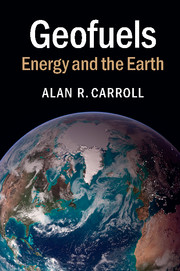Book contents
- Frontmatter
- Contents
- Acknowledgments
- 1 Introduction
- 2 The Living Earth
- 3 Warmed from Above: Solar Energy
- 4 Wind, Water, and Waves: Energy from the Fluid Earth
- 5 Covered in Green: Biofuels Basics
- 6 Fossil Farming: The Geologic Underpinnings of Biofuels
- 7 The Light of an Ancient Sun: Fossil Fuel Origins
- 8 Digging for Daylight: Coal and Oil Shale
- 9 Skimming the Cream: Conventional Oil and Gas
- 10 Stuck in the Mud: Fossil Fuels That Fail to Flow
- 11 Petrified Petroleum: Oil Sand and Gas Hydrate
- 12 Water, Water, Everywhere
- 13 Primordial Power: Geothermal and Nuclear
- 14 Out of Sight, Out of Mind: Geologic Waste Disposal
- 15 How Long Is Forever? Energy and Time
- 16 Conclusions
- Index
- References
7 - The Light of an Ancient Sun: Fossil Fuel Origins
Published online by Cambridge University Press: 05 March 2015
- Frontmatter
- Contents
- Acknowledgments
- 1 Introduction
- 2 The Living Earth
- 3 Warmed from Above: Solar Energy
- 4 Wind, Water, and Waves: Energy from the Fluid Earth
- 5 Covered in Green: Biofuels Basics
- 6 Fossil Farming: The Geologic Underpinnings of Biofuels
- 7 The Light of an Ancient Sun: Fossil Fuel Origins
- 8 Digging for Daylight: Coal and Oil Shale
- 9 Skimming the Cream: Conventional Oil and Gas
- 10 Stuck in the Mud: Fossil Fuels That Fail to Flow
- 11 Petrified Petroleum: Oil Sand and Gas Hydrate
- 12 Water, Water, Everywhere
- 13 Primordial Power: Geothermal and Nuclear
- 14 Out of Sight, Out of Mind: Geologic Waste Disposal
- 15 How Long Is Forever? Energy and Time
- 16 Conclusions
- Index
- References
Summary
The fuel [Egyptian railroaders] use for the locomotive is composed of mummies three thousand years old, purchased by the ton or by the graveyard for that purpose, and sometimes one hears the profane engineer call out pettishly, “D–n these plebeians, they don't burn worth a cent - pass out a King!”
Mark Twain, The Innocents Abroad (1869)Where do fossil fuels really come from? Misconceptions about the true origin of these substances abound. One chain of gas stations uses an image of a green dinosaur as its logo; does this mean that the gasoline it sells comes from dead dinosaurs? If so, where are those rotting carcasses actually located? Directly under the gas station? The idea that oil is produced from dinosaurs is not quite so comical as it might first appear, since historically we have indeed obtained oil from the carcasses of large animals. The most famous of these are whales, some species of which were hunted nearly to extinction in the 19th century for lamp oil and lubricants. Oil in the form of animal fat continues to be rendered in large quantities for food use, but has not been widely burned for illumination since the advent of fossil fuels.
Most people's direct experience of petroleum begins and ends with the self-service pump at a gas station. The fill-up procedure is deceptively easy and quick, but in fact the hose transfers energy to your car at an astounding rate. Power is defined as the rate at which energy is transferred; delivering the energy content of 15 gallons of gasoline in 2 minutes works out to be the equivalent of about 20,000 horsepower! If you could afford to keep this flow rate going continuously it would be enough to power one engine of a medium-size jetliner. For the most part though consumers do not have direct contact with fossil energy sources at all. Natural gas, for example, travels invisibly in underground pipelines, and coal-fired power plants are often located far from the end users of the electricity they generate.
- Type
- Chapter
- Information
- GeofuelsEnergy and the Earth, pp. 123 - 141Publisher: Cambridge University PressPrint publication year: 2015



